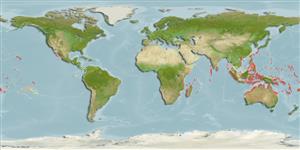分类 / Names
俗名 | 同种异名 | Catalog of Fishes(属, 种) | ITIS | CoL | WoRMS | Cloffa
Teleostei >
Ovalentaria/misc (Various families in series Ovalentaria)
鱸形目 (Various families in series Ovalentaria) >
Pomacentridae (Damselfishes)
雀鯛科(Damselfishes) (Damselfishes) > Pomacentrinae
Etymology: Chrysiptera: Greek, chrysos = golden + Greek, pteron = fin, wing (Ref. 45335).
More on author: Cuvier.
Environment: milieu / climate zone / depth range / distribution range
生态学
海洋 礁区鱼类; 非迁移的; 深度上下限 0 - 3 m (Ref. 30874). 热带; 30°N - 28°S
Indo-Pacific: East Africa to the Line and Pitcairn islands, north to Japan, south to Australia.
印度-太平洋: 东非到列岛群岛与皮特凯恩群岛,北至日本, 南至澳洲。
大小 / 重量 / 年龄
Maturity: Lm ? range ? - ? cm
Max length : 11.5 cm TL 雄鱼/尚未辨别雌雄; (Ref. 90102)
背棘 (总数): 13; 背的软条 (总数): 12-13; 臀棘 2; 臀鳍软条: 11 - 13.
稚鱼是色彩艳丽的蓝色, 但是颜色淡的体色而不是像 C. cyaneus 一样的壮观, 变成暗蓝灰色随着成长。
Adults occur among rubble or consolidated reef rock of exposed intertidal reef flats and sandy beaches, subject to mild surge. Also near freshwater run-offs (Ref. 48636). They occur in small groups. Feed mainly on benthic algae. Oviparous, distinct pairing during breeding (Ref. 205). Eggs are demersal and adhere to the substrate (Ref. 205). Males guard and aerate the eggs (Ref. 205). Diurnal species (Ref. 54980; 113699).
在碎石或者暴露在潮间带礁石平台与沙滩的坚硬岩礁之中生存, 受温和的涌浪支配。 也在淡水的溢流附近.(参考文献 48636) 形成小群鱼群。 主要吃底部的藻类。
Life cycle and mating behavior
成熟度 | 繁殖 | 产卵场 | 卵 | 孕卵数 | 仔鱼
Oviparous, distinct pairing during breeding (Ref. 205). Eggs are demersal and adhere to the substrate (Ref. 205). Males guard and aerate the eggs (Ref. 205).印度-太平洋: 东非到列岛群岛与皮特凯恩群岛,北至日本, 南至澳洲。
Allen, G.R., 1991. Damselfishes of the world. Mergus Publishers, Melle, Germany. 271 p. (Ref. 7247)
人类利用
渔业: 低经济
更多信息
参考文献养殖养殖信息品种遗传学Electrophoreses遗传率疾病加工NutrientsMass conversion
工具
特别资料
下载 XML
网络资源
Estimates based on models
Preferred temperature (Ref.
123201): 25.1 - 29.3, mean 28.5 °C (based on 2423 cells).
Phylogenetic diversity index (Ref.
82804): PD
50 = 0.5000 [Uniqueness, from 0.5 = low to 2.0 = high].
Bayesian length-weight: a=0.01479 (0.00642 - 0.03409), b=3.00 (2.80 - 3.20), in cm total length, based on LWR estimates for this (Sub)family-body shape (Ref.
93245).
营养阶层 (Ref.
69278): 2.4 ±0.3 se; based on diet studies.
Generation time: 1.4 ( na - na) years. Estimated as median ln(3)/K based on 1
growth studies.
回复力 (Ref.
120179): 高度, 族群倍增时间少于 15个月 (K=0.8).
Fishing Vulnerability (Ref.
59153): Low vulnerability (17 of 100).
Nutrients (Ref.
124155): Calcium = 141 [76, 247] mg/100g; Iron = 0.917 [0.533, 1.515] mg/100g; Protein = 18.7 [17.5, 19.8] %; Omega3 = 0.114 [0.066, 0.196] g/100g; Selenium = 16.1 [8.9, 31.3] μg/100g; VitaminA = 111 [34, 369] μg/100g; Zinc = 2.39 [1.59, 3.41] mg/100g (wet weight);
